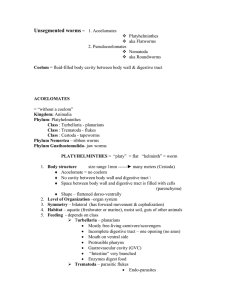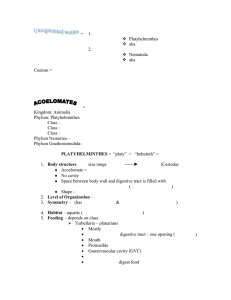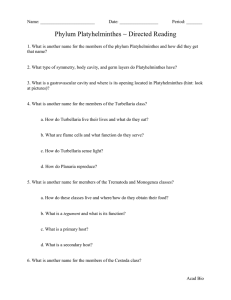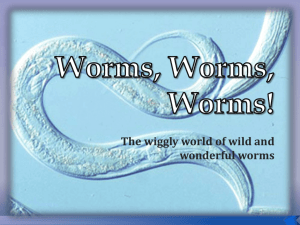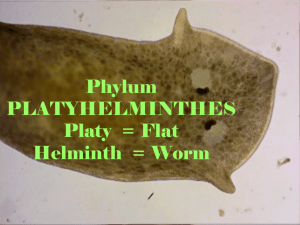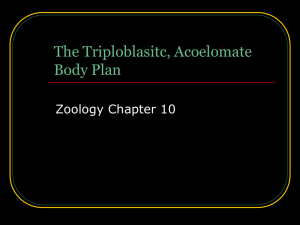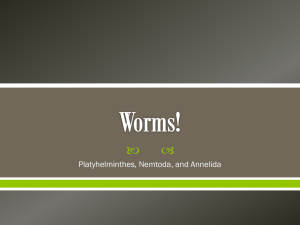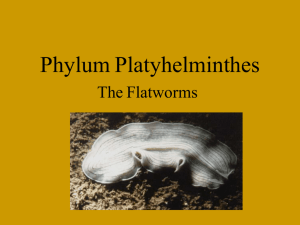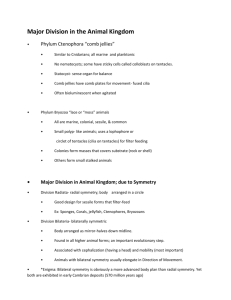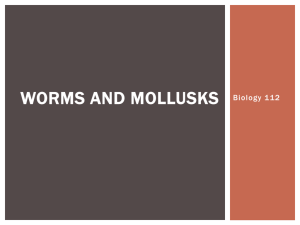Unsegmented Worms Phylum Platyhelminthes
advertisement
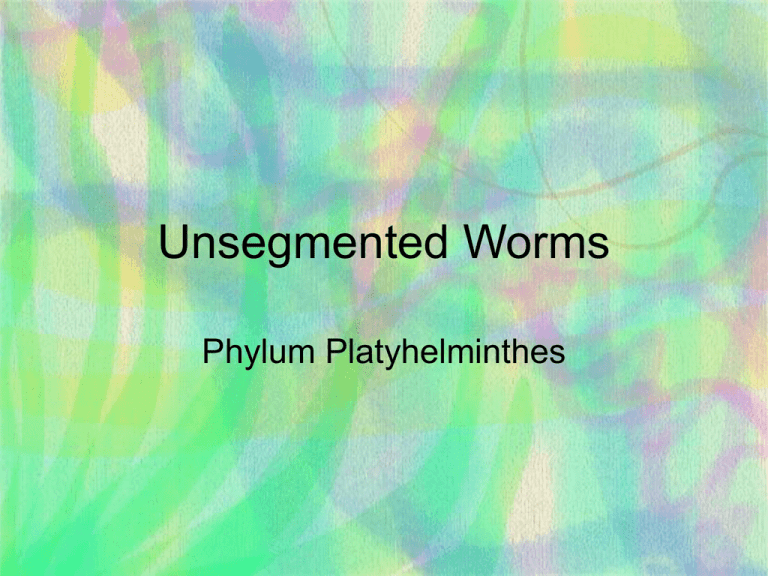
Unsegmented Worms Phylum Platyhelminthes I. Unsegmented worms A. = Worms that are not divided into sections externally & internally B. E.g. 1. Phylum Platyhelminthes aka flatworms 2. Phylum Nematoda aka Roundworms C. What is a coelom? = fluid-filled body cavity between body wall & digestive tract Kinds of coelom 1. Acoelomate= no coelom i.e. body cavity is NOT fluid filled Kinds of coelom 2. Pseudocoelomate = Fluid filled body cavity BUT No mesentary or peritoneum Kinds of coelom 3. Eucoelomate = True coelom w/ mesentary (holds gut in place) & peritoneum (mesodermal lining of body cavity D. Phylum Platyhelminthes 1. Class : Turbellaria – planarians 2. Class : Trematoda – flukes 3. Class : Cestoda – tapeworms D. Phylum Platyhelminthes Also Acoelomate: • Phylum Nemertea – ribbon worms • Phylum Gnathostomulidajaw worms E. General Info re: Flatworms 1. = “platy” = flat “helminth” = worm 2. Body structure a. Size range 1 mm ------► many meters (Cestoda) b. Shape – flattened dorso-ventrally c. Only several cell layers thick E. General Info re: Flatworms Cells fill body cavity (not fluid) F. Level of Organization = organ system G. Symmetry • • bilateral (has forward movement & cephalization) I ‘m a little bilateral animal too! H. Habitat • aquatic (freshwater or marine) • moist soil • endoparasites of vertebrates I. Feeding - Class Turbellaria Planariansmostly free-living carnivore or scavengers I. Feeding - Class Turbellaria – Incomplete digestive tract – one opening (no anus) – Mouth on ventral side – Protrusible pharynx – Gastrovascular cavity (GVC) – “Intestine” very branched – Enzymes digest food I. Feeding - Class Trematoda • Parasitic flukes • endoparasites of vertebrates • need only minimal digestive tract • E.g. Human Liver fluke I. Feeding – Class Cestoda tapeworms scolex –Endo-parasites –Scolex w/ hooks & suckers –NO need for dig. tract – absorbs nutrients from gut of host suckers J. Respiration • • - via diffusion (only a few cell layers thick) K. Internal transport • via diffusion Marine flatworm L. Excretion – via diffusion • • • • EXCEPTION: planarians have flame cells ( w/ flagella that help move waste to excretory pores, then out of the body M. Response – (Nervous system) 1. Primitive brain – anterior ganglia ganglion = cluster of nerve cells 2. Two Longitudinal nerves (the length of the body) 3. Ladder-like cross-bridges of nerves M. Response – (Nervous system) M. Response – (Nervous system) 4. Sense organs: (flatworms) a. Ocelli – eyespots / photodetectors b. Auricles contain chemoreceptors (chemicals) & thigmoreceptors (touch) c. Statocysts – balance d. Rheoreceptors – sense direction of water current N. Locomotion - Planaria – use cilia, slime, circular and longitudinal muscles to GLIDE – Trematoda, Cestoda – little motion cilia O. Reproduction 1. Asexual – Regeneration (Planaria only) 2. Sexual – a. pattern = monoecious (hermaphrodites) b. cross- fertilization (swap sperm) P. Ecological Roles 1. Scavengers/ predators – recycle nutrients to ecosystem (Class Turbellaria) 2. Prey for fish & birds (Class Turbellaria) 3. Endo-parasites (cause disease) (Class Trematoda & Class Cestoda)
